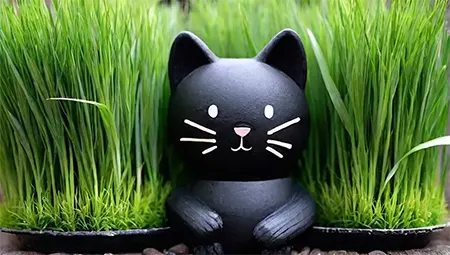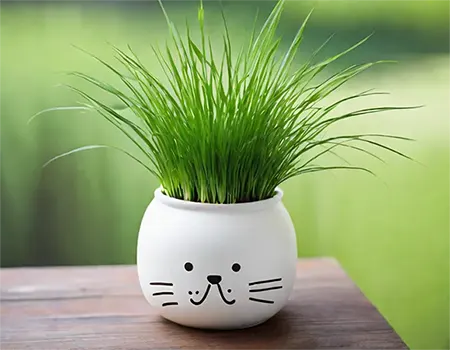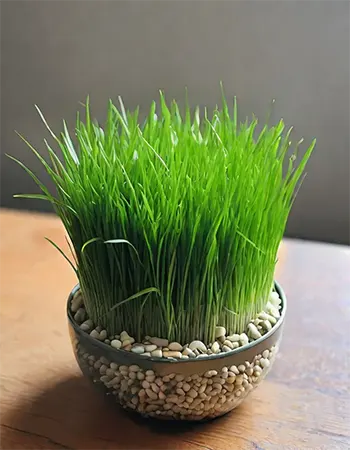The Definitive Guide to Cat Grass: Your Feline's Green Oasis
For centuries, cats have been drawn to the green allure of grass, nibbling and grazing with seemingly insatiable curiosity. But what exactly is this leafy obsession, and what role does it play in your feline friend's life? This comprehensive guide delves into the world of cat grass, from its origins and benefits for your furry companion.

Ditch the Turf, Embrace the Blend: Why Cat Grass Isn't Just Your Average Lawn
The term "cat grass" might conjure images of your feline friend munching on the backyard lawn. However, this comparison does a disservice to the unique and carefully crafted nature of true cat grass. Here's why:
Beyond the Blade: A Mix of Seeds, Not Just Grass
Unlike the single-species turf covering your lawn, cat grass is a curated blend of various seeds, most commonly wheat, barley, oats, or rye. This diversity ensures a balanced nutritional profile and caters to different feline preferences. Imagine a gourmet salad for your cat, offering a variety of textures and flavors instead of a monotonous patch of green.
Safety First: Pesticide-Free and Feline-Friendly
One of the main concerns with outdoor grass is the potential presence of pesticides and fertilizers. These chemicals can be harmful to your cat if ingested, even in small amounts. Cat grass, on the other hand, is specifically grown indoors in controlled environments free of such harmful substances. Think of it as a haven for your cat to enjoy their greens without any worries.
A Palate-Pleasing Proposition:
Unlike the often tough and bitter grass outdoors, cat grass is chosen for its tender, sweet, and easily digestible nature. This makes it much more appealing to your cat's taste buds, encouraging them to explore and nibble without hesitation.
More Than Just a Snack: A Green Oasis for Exploration
Cat grass isn't just about satisfying hunger; it's about providing a stimulating environment for your cat's natural instincts. The texture, smell, and even the act of grazing itself can be enriching and enjoyable for your feline companion. Imagine a miniature jungle for your cat to explore, right in your living room!
By understanding the unique composition, safety measures, and feline-friendly appeal of cat grass, we can move beyond the misconception of "just grass" and appreciate its true value as a carefully crafted green haven for our furry companions.
Beyond a Playful Munch: How Cat Grass Aids Digestion and Hairball Woes
While cats nibbling on grass might seem like a playful habit, it serves a crucial purpose in their digestive health. Cat grass, with its fibrous content, acts like a natural internal brush for your feline friend. Here's how it works:

Hairball Hero: Combating the Furry Foe
As your cat grooms, they ingest loose fur. This fur can accumulate in their stomachs, forming dreaded hairballs. Passing these hairballs can be uncomfortable and even lead to blockages. Rich in fiber, cat grass helps lubricate the digestive tract and gently stimulates the muscles. This "internal brushing" action helps move hairballs through the system more smoothly, reducing the risk of blockages and discomfort. Imagine it as a gentle nudge from within, helping your cat expel those pesky furballs more easily.
Aiding Digestion: Beyond Hairballs
The fiber in cat grass doesn't just tackle hairballs; it plays a vital role in overall digestion. Fiber helps regulate the movement of food through the intestines, promoting healthy bowel function and preventing constipation. This can particularly benefit senior cats or those with sensitive digestive systems.
A Nutritional Nibble: Trace Minerals and Vitamins
While not a primary source of nutrients, cat grass might contain trace minerals and vitamins like B vitamins and folic acid. These can offer a small nutritional boost to your cat's diet, supporting overall well-being. Think of it as a healthy side dish complementing their regular meals.
Especially for the Furry Factor: Longhaired Breeds and Hairballs
Longhaired breeds are particularly prone to hairball formation due to the sheer amount of fur they ingest while grooming. For these furry friends, cat grass can be an even more valuable tool in their digestive arsenal. The increased fiber effectively aids in hairball prevention and management, keeping your longhaired feline companion happy and comfortable.
By understanding the specific mechanisms of how cat grass helps with digestion and hairballs, we can appreciate its true value as a natural and safe aid for our feline friends' well-being. It's more than just a playful nibble; it's a crucial part of their digestive health and overall well-being.
A Feast for the Senses: Indulging the Natural Urge to Graze
Millions of Years of Grassy Instincts:
Step back in time, millions of years ago. Your cat's ancestors, sleek and agile, stalked prey in vast, sun-dappled grasslands. Their keen senses were honed to navigate this environment, their bodies built for silent pounces and swift chases. The tall grasses provided cover offered scents of potential prey, and even served as a source of nutrition by grazing on small animals that fed on the grass itself.
The Urge to Graze Lives On:
Fast forward to today's pampered house cats. Though their hunting grounds may have shrunk to your living room, the ancient instincts remain deeply ingrained. The urge to stalk, pounce, and explore still burns brightly within them. While they may no longer chase actual prey, they often channel this energy into playful behaviors like batting at toys or chasing dust bunnies.
Cat Grass: A Miniature Jungle Adventure:
Enter cat grass, a safe and enriching outlet for these innate desires. Its verdant appeal evokes the memory of those ancestral hunting grounds. The texture under their paws mimics the soft crunch of grass, the scent tingles their senses, and the act of nibbling satisfies a primal urge.
Beyond Play, a Mental Boost:
But it's not just about play. Cat grass provides essential mental stimulation, crucial for preventing boredom and destructive behaviors. Imagine it as a miniature jungle adventure right in their living room! They can stalk imaginary prey, hide and ambush "danger," and explore a new sensory landscape. This mental workout keeps them engaged, happy, and less likely to resort to mischief.
Personalizing the Experience:
Remember, each cat is unique. To truly unleash the magic of cat grass, personalize the experience. Add a sprinkle of catnip for extra allure, create tunnels and hiding spots around the grass, or place it near a window for bird-watching opportunities. Observe your cat's individual preferences and tailor the environment to ignite their inner explorer.
By understanding the deep connection between cats, grass, and their instincts, we can transform cat grass from a simple plant to a portal to their wild side. It's a chance to reconnect with their heritage, fulfill their natural desires, and provide essential mental stimulation for a happy and fulfilled feline companion.

The Cat Grass Distraction: Protecting Your Precious Plants
Does your heart skip a beat every time you see your furry friend eyeing your prized philodendron? Do you constantly worry about toxic houseplants falling victim to curious kitty nibbles? Fear not, the secret weapon you seek lies in the humble, yet irresistible, cat grass.
The Allure of the Green Oasis:
Imagine your cat as a tiny explorer, drawn to the vibrant green world of your houseplants. The lush foliage offers a tempting invitation to investigate, nibble, and perhaps even conquer. But here's the secret: cat grass, with its carefully curated blend of seeds and irresistible taste, offers a much more appealing adventure.
Taste Buds Triumphant:
Unlike the often bitter or bland leaves of houseplants, cat grass boasts a sweet, tender texture and a flavor reminiscent of fresh greens. It's a sensory experience designed to tantalize your feline's taste buds, drawing them away from the potentially harmful allure of your houseplants. Think of it as a gourmet salad compared to a bland side dish - the choice is clear for even the most discerning feline palate.
More Than Just a Snack:
Beyond taste, cat grass provides a stimulating environment that caters to your cat's natural instincts. The act of grazing mimics their ancestral foraging behavior, while the texture engages their paws and senses. This enriching experience fulfills their curiosity and provides a safe outlet for exploring their wild side, making houseplants seem less tempting in comparison.
A Win-Win Situation:
By offering cat grass, you're not just protecting your precious plants, you're enriching your cat's life. They get a safe and satisfying nibble, mental stimulation, and a chance to connect with their inner explorer. You, on the other hand, get peace of mind knowing your leafy friends are safe and your feline companion is happy and healthy.
Remember:
It's important to choose cat grass specifically designed for indoor use and free of pesticides or harmful chemicals. Ensure it's readily available in a convenient location and replace it regularly to maintain its freshness and appeal.
By understanding your cat's needs and offering them the irresistible world of cat grass, you can create a harmonious household where both your plants and your feline friend can thrive.
A Purrfectly Historical Connection: Cats and Grass Through the Ages
Did you know your cat's love for greenery has a fascinating history? The bond between cats and grass stretches back centuries, even millennia! Take a trip down memory lane:
Ancient Egyptians:
In the cradle of civilization, cats were revered as sacred beings. Depictions on temple walls and tombs showcase cats playfully nibbling on papyrus reeds, highlighting their natural connection to greenery. This early association suggests that even our feline ancestors enjoyed the pleasures of grass.
Beyond Egypt:
Across cultures and continents, cats have been observed interacting with grass. From Japanese woodblock prints featuring cats frolicking in meadows to European folklore depicting witches' familiars drawn to fields, the connection between cats and grass seems deeply ingrained.
Modern Twists on an Ancient Tradition:
Today, we can offer our feline companions a taste of this historical connection with cat grass. While basic trays are a great option, consider exploring new possibilities:

- Outdoor Cat Grass Patch: Create a dedicated green space in your yard, ensuring it's free of pesticides and chemicals. Use fencing or netting to keep your cat safe while allowing them to explore and graze.
- Catnip-Infused Grass: Add a sprinkle of catnip to your indoor cat grass for an extra enticing twist. This irresistible herb stimulates their senses and encourages them to engage with the grass.
- DIY Cat Grass Jungle: Get creative! Build tunnels, hide treats, or add cat toys around the cat grass to create a stimulating and enriching environment.
Always Remember Safety First:
No matter which option you choose, safety is paramount. Ensure any outdoor patches are free of harmful chemicals and supervise your cat when they're exploring. Choose cat grass specifically grown for indoor use and replace it regularly to maintain freshness.
By understanding the historical connection and exploring modern possibilities, we can offer our cats a safe and enriching experience that honors their natural instincts and celebrates their unique relationship with the green world. So, let your feline friend embark on their own historical adventure with a touch of catnip and a patch of green!
Frequently Asked Questions: Addressing Your Cat Grass Concerns
- How often should I replace the cat grass? Every 1-2 weeks, depending on growth and potential mold concerns.
- Can my cat eat too much cat grass? While rare, overconsumption might lead to digestive upset. Monitor your cat's intake and consult a vet if concerned.
- What if my cat shows unusual behavior after eating cat grass? Consult your veterinarian for professional advice.
Beyond a Plant: A Gateway to Your Cat's Happiness
Imagine your cat, eyes sparkling with curiosity, nestled amidst a verdant patch of cat grass. They nibble with contentment, their senses engaged by the soft texture and fresh scent. This isn't just a plant; it's a portal to their inner wild, a haven where their natural instincts can flourish.
Cat grass is more than just a solution to hairballs or a distraction from houseplants. It's a vital piece of your feline friend's well-being, offering:
- A Touch of Nature Indoors: Cats crave the sights, smells, and textures of the natural world. Cat grass brings a piece of that outdoorsy adventure right inside, satisfying their innate curiosity and enriching their environment.
- Instinctual Fulfillment: The act of grazing, stalking imaginary prey, and batting at blades of grass allows your cat to express their natural hunting behaviors in a safe and playful way. This mental and physical stimulation keeps them happy, engaged, and less likely to engage in destructive behaviors.
- A Digestive Ally: The fiber in cat grass aids digestion, helping to prevent hairballs and promoting a healthy gut. It's like a natural internal brush, ensuring your cat feels their best.
- A Joyful Connection: Watching your cat explore and enjoy their cat grass is a heartwarming experience. It strengthens your bond and brings you closer to your furry companion.
Create Your Cat's Green Oasis Today:
Why wait? Embrace the joy of cat grass and witness the transformation in your feline friend. It's simple, affordable, and incredibly rewarding. So, choose a sunny spot and watch your cat's happiness bloom alongside the verdant haven you create. Remember, it's not just a plant; it's a gateway to a happier, healthier, and more fulfilled cat.
Further reading - Rideau Lakes - Power microgreens! | Microgreens for kids? | Power Up Athletes | Partnering with chefs

